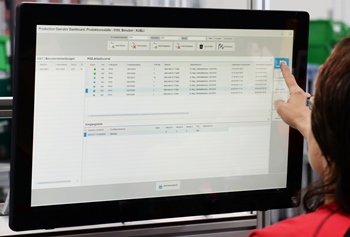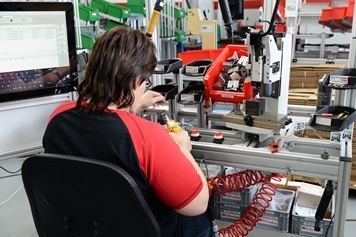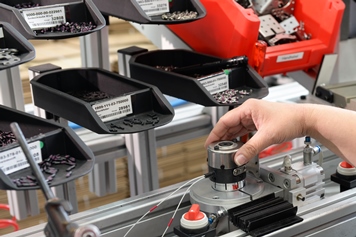Strategic building block for the industry - introduction of SAP ME with IGZ
The Ortlinghaus group was founded in 1898. As a manufacturer of clutches, brakes, lamella and compact drives ? including hydraulic units as well as regulating and control units ? the producer is partner for many industries. Now in its fourth generation, family-run company operates production sites in Germany, Switzerland and China. Ortlinghaus has its headquarters in Wermelskirchen and relies on the values of sustainability, growth and innovation.
At its Swiss site GAMS, series products as well as customer-specific designs are manufactured. Based in GAMS, the manufacturer undertakes deliveries from 38 countries worldwide. For this purpose, about 53,000 goods movements are required, where 36,500 sorts of material are accessed. Order processing takes place via 125 work places connected with the existing enterprise resource planning system SAP ERP. Capacity planning and production scheduling is carried out via the module of SAP APO (advanced planning and optimisation).
The foundation stone of digital transformation

On the way to Industry 4.0, a central significance is attributed to the development and comprehensive use of MES functionalities in all manufacturing industries. To secure competitive advantages and continue to economically operate on the market, the demands on the planning and control of manufacturing processes increase continuously. Manufacturing execution systems support
these tasks and are thus important building blocks on the way to the connected manufacturing and Industry 4.0. SAP MES SE is the standard production control software of SAP and helps its users to create a continuous, cross-site information and data flow in real-time.
It is a hub for the standard integration from the machine level up to the ERP system. For this, the MES is equipped with comprehensively configurable options both for production data acquisition (PDA) as well as the machine connection (MDE). The application thereby copes with common industry standards such as OPC, TCP/IP and many more. Functionally, tool contributes comprehensive MES functionality for instance for job fine control, capturing the overall equipment effectiveness, as well as statistical process control.
Every year 8,600 work schedules and 40,000 feedbacks

At Ortlinghaus an SAP based standard solution for automated production control was quickly used. The reasons were the high standard integration of the system and its connection to the existing business solution SAP ERP. During the processing of manufacturing orders in the past, some 8,600 work schedules with 34,000 operations were generated in paper form and 40,000 feedbacks issued. The production company no longer wanted to accept the costs associated with the processing of these documents. Need for action consisted, inter alia, in view of the growing demands in terms of traceability throughout the entire production process, also in accordance with customer requirements. "Additional requirements were reflected in that we wanted to be quick, and independent of persons in the order processing.
The flood of documents, in the form of test, assembly and packaging instructions, should be controlled properly and goal-oriented. Manual data collection such as test documentation had to be eliminated entirely", says Christian Kubli, head of SCM at Ortlinghaus in Gams. Positive for the installed solution was that these features were already included in the standard. The project house IGZ from Falkenberg was commissioned with the introduction of the system due to its focus on the SAP manufacturing suite.
Moreover, the team convinced in the implementation analysis with the necessary expertise to carry out such a project and already communicated deadlines and costs early, transparently and precisely. But also, the so-called 'soft skills' at human level tipped the scale, explains Christian Kubli. With a structured approach of the project team, the implementation was possible parallel to the operation. During this time, the challenge of production operation was primarily to advance the project 'by the way'. Because everyone involved had to continue to meet the tasks in the line function assigned to him.
No handwritten papers in the workshop

With the manufacturing execution system of the SAP software manufacturer, Ortlinghaus could implement the requirements for a full traceability and transparency throughout the entire production process, as required. The figure of the history of the product is used for internal quality assurance, as well as the audits and helps to meet the documentation requirements to customers. The administrative and time required for documents and drawings of the manufacturing process, as previously incurred by manual printing and distribution of paper, could be saved by 100 percent. In addition, after introduction of the system, it is ensured that all drawings and documents are always updated executed correctly and are automatically electronically available in the right quantity. The overview and organisation of assembly instructions in partly 65 pages of paper was completely converted to electronic work instructions with 3D visualisation. This allows the workers the system-guided assembly at every workstation. It is now no longer necessary to flap the pages in a time-consuming manner in unclear folders. Data collections and feedback, for example, for test certificates and protocols, are now also automatic. With the elimination of manual data collection, errors repeatedly incurred in this operation have also largely disappeared.
Collecting reliable master data in the system.
Only a high quality of master data makes many improvement initiatives in production possible MES contributes also here: On the basis of actual, automatic actual-time recording, setpoint / actual deviations are now determined. Deviations can be corrected promptly. So master data optimisation improved in this manner on the basis of the real actual times ensures consistent contributions and allows adequate production planning. The backlog of orders is visualised at all workplaces and can be controlled online via production planner. The comprehensible prioritising and rescheduling of ongoing production orders is consistently possible.
By means of active WIP management in SAP ME, circulation stocks can be controlled accurately. Only materials actually required for the current production status are in circulation. In this way inventory levels could be reduced and throughput times reduced significantly. This was particularly evident for short production orders such as equipping, installing, testing and dispatch. Without these disruptive effects on the manufacturing process, for example the manual recording, email and telephone communication as a result of an order prioritisation and general paper-laden production control ? error rate in the works was reduced. A process lock prevents inspection and control steps being forgotten and therefore defective parts are passed on through different manufacturing stages. The system visualizes matching information and messages, so that the staff can respond promptly and correctly.
Future integrations and updates at a glance
The scalable and configurable production control software of SAP SE is designed for performance and flexibility without sacrificing a high degree of standardisation. As is typical for many applications of SAP, the MES solution can be largely configured and extended without limiting the release ability. The Ortlinghaus group of companies has expanded their SAP strategy to the production level with the roll-out of the solution.
In particular, the thought of future integrations and the release capability of their system world play a role in this decision. The implementation of the manufacturing execution system in GAMS, however, was not purely self-serving: "It has been shown by various customer audits that issues such as traceability, change process, document control, protocols and order management must be addressed broadly", explains Christian Kubli. The process reliability could therefore be kept at the highest level. This is also pay off in that the processes in the course of the implementation are always questioned and have been adjusted ? if required. The standardisation of processes at this point was used, just as the Walldorf solution earlier.
Back to overview

